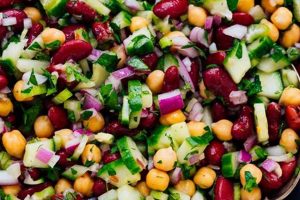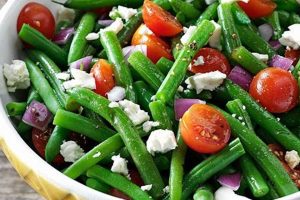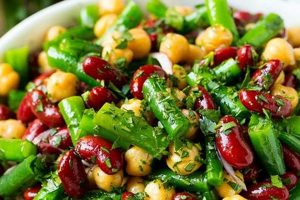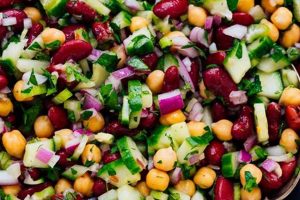A simple, refreshing dish typically combines three varieties of beans, such as kidney, cannellini, and black beans, with a vinaigrette dressing. Often, diced bell peppers, red onion, and fresh herbs like parsley or cilantro are added. Variations might include corn, olives, or different herbs and spices to create unique flavor profiles. This type of salad provides a versatile base, allowing for customization based on individual preferences and dietary needs.
This salad offers a healthy and budget-friendly meal option. Beans are an excellent source of protein, fiber, and complex carbohydrates, contributing to satiety and digestive health. The colorful additions of vegetables increase the vitamin and mineral content. Furthermore, these salads are easy to prepare, store well, and can be served as a side dish or a light main course, making them suitable for picnics, potlucks, and everyday meals. Historically, combining beans and other readily available ingredients has been a practical way to create nutritious and affordable meals across various cultures.
This exploration will delve into specific examples of these versatile salads, covering diverse flavor combinations, ingredient selection, preparation methods, and nutritional information. Further discussion will also address adaptations for dietary restrictions and suggest serving ideas.
Tips for Creating Excellent Three-Bean Salads
Optimizing ingredient selection and preparation techniques elevates these simple salads from satisfactory to exceptional. Attention to detail ensures a flavorful and visually appealing dish.
Tip 1: Bean Selection and Preparation: Utilize canned beans for convenience, or enhance flavor by cooking dried beans from scratch. Ensure thorough rinsing of canned beans to remove excess starch and sodium. If using dried beans, soak and cook them according to package directions for optimal texture.
Tip 2: Balancing Flavors: Achieve a harmonious balance of sweet, tangy, and savory elements in the vinaigrette. A classic combination includes olive oil, vinegar, Dijon mustard, and honey or maple syrup. Experiment with different types of vinegar, such as red wine, apple cider, or balsamic, to create unique flavor profiles.
Tip 3: Enhancing Visual Appeal: Incorporate a variety of colors and textures. Choose beans with contrasting hues, such as red kidney beans, white cannellini beans, and black beans. Dice vegetables uniformly for a professional presentation. Fresh herbs provide a vibrant garnish.
Tip 4: Proper Marinating Time: Allow the salad to marinate for at least 30 minutes, or preferably longer, in the refrigerator. This allows the flavors to meld and the beans to absorb the dressing, resulting in a more cohesive and flavorful dish.
Tip 5: Texture Considerations: Maintain a pleasant textural variety. Blanch or roast vegetables like bell peppers to soften them slightly while retaining some crispness. Avoid overcooking the beans, which can result in a mushy texture.
Tip 6: Customization and Additions: Adapt the recipe to suit individual preferences. Add ingredients such as corn kernels, chopped celery, red onion, or olives for additional flavor and texture. Experiment with different herbs and spices, such as cumin, chili powder, or oregano.
Tip 7: Storage and Serving: Store leftover salad in an airtight container in the refrigerator for up to three days. Serve chilled as a side dish, a light lunch, or part of a buffet spread.
By following these guidelines, one can consistently produce a delicious and visually appealing three-bean salad that complements a variety of meals and occasions.
These tips provide a foundation for creating a successful three-bean salad. The following section will offer specific recipe examples and variations to further inspire culinary creativity.
1. Bean Variety
Bean variety forms the foundation of a successful three-bean salad. Diversity in bean selection contributes not only to visual appeal but also to nutritional value, textural complexity, and flavor depth. Employing a range of beans offers a broader spectrum of nutrients and creates a more satisfying culinary experience. Different beans possess unique flavor profiles and textures; for instance, kidney beans offer a robust, earthy flavor and firm texture, while cannellini beans contribute a creamy texture and mild, nutty taste. Black beans provide a deep color, soft texture, and slightly sweet flavor. This interplay of textures and tastes elevates the overall sensory experience.
The strategic selection of beans allows for customization based on dietary needs and preferences. One might opt for a combination of high-fiber beans, such as kidney and black beans, to promote digestive health. Alternatively, incorporating chickpeas adds a different dimension of flavor and texture while providing a good source of protein and iron. Examples of successful combinations include kidney, cannellini, and black beans for a classic presentation; chickpeas, pinto beans, and green beans for a Southwestern flair; or cranberry beans, navy beans, and great northern beans for a subtler flavor profile.
In conclusion, the considered selection of beans is paramount to achieving a well-balanced and flavorful three-bean salad. Variety enhances nutritional content, provides textural intrigue, and contributes to a visually appealing dish. Understanding the unique characteristics of different beans allows for informed choices that cater to individual preferences and dietary goals, resulting in a more satisfying and healthful meal. Thoughtful bean selection elevates a simple salad to a culinary creation that delights both the palate and the eye.
2. Dressing Vibrancy
Dressing vibrancy plays a crucial role in elevating three-bean salads from simple to exceptional. The dressing is not merely a coating but a vital component that unifies the diverse flavors and textures, creating a cohesive and enjoyable culinary experience. A well-crafted dressing enhances the inherent flavors of the beans and other ingredients, adding depth and complexity.
- Acidity as a Flavor Enhancer
Acidity, primarily derived from vinegar or citrus juice, provides brightness and balances the earthy flavors of the beans. The sharpness of the acid cuts through the richness of the beans and other ingredients, creating a more refreshing and palatable dish. Examples include red wine vinegar for a robust flavor, apple cider vinegar for a milder tang, or lemon juice for a citrusy twist. The level of acidity should complement the other flavors in the salad without overpowering them.
- The Role of Oil in Texture and Flavor
Oil contributes to the dressing’s texture, acting as a carrier for flavors and creating a smooth, cohesive consistency. The type of oil influences the overall flavor profile. Extra virgin olive oil offers a fruity and peppery note, while avocado oil provides a neutral base that allows other flavors to shine. The oil also helps to distribute the dressing evenly across the salad, ensuring that each bite is well-seasoned.
- Sweetness as a Balancing Element
A touch of sweetness balances the acidity and adds depth to the dressing. Honey, maple syrup, or a small amount of sugar can achieve this balance. The sweetness should be subtle and not overpower the other flavors. It enhances the overall complexity of the dressing, creating a more harmonious and well-rounded flavor profile.
- Aromatic Enhancements through Herbs and Spices
Fresh herbs and spices contribute aromatic complexity and enhance the overall vibrancy of the dressing. Freshly chopped parsley, cilantro, or mint add brightness, while dried herbs like oregano or thyme provide earthiness. A pinch of red pepper flakes can add a subtle heat, while a dash of cumin or coriander introduces warm, savory notes. The choice of herbs and spices should complement the other flavors in the salad and create a balanced, layered flavor profile.
These facets of dressing vibrancy work synergistically to create a dressing that not only complements the three-bean salad but elevates it to a more sophisticated and satisfying dish. The interplay of acidity, oil, sweetness, and aromatics ensures a balanced and flavorful experience that enhances the natural flavors of the beans and other ingredients. Careful consideration of these elements allows for customization and experimentation, resulting in a dressing perfectly suited to individual preferences and the overall composition of the salad.
3. Fresh Ingredients
Fresh ingredients are essential for maximizing the flavor, texture, and nutritional value of three-bean salads. These salads, while inherently nutritious due to the beans, significantly benefit from the incorporation of fresh produce. The interplay between the beans and fresh elements creates a more dynamic and appealing sensory experience. Fresh ingredients contribute brightness, crispness, and nuanced flavors that complement the heartiness of the beans. For example, a diced bell pepper introduces sweetness and a satisfying crunch, while chopped red onion adds a pungent bite and vibrant color. Fresh herbs, such as parsley or cilantro, provide aromatic complexity and a refreshing lift. The inclusion of these components elevates the salad beyond a simple combination of beans and dressing, transforming it into a vibrant and flavorful dish.
Beyond enhancing flavor and texture, fresh ingredients contribute to the nutritional density of three-bean salads. Fresh vegetables are rich in vitamins, minerals, and antioxidants, complementing the protein and fiber provided by the beans. This combination creates a nutrient-rich meal that supports overall health and well-being. Furthermore, the use of fresh ingredients allows for seasonal variations. Summer salads might feature ripe tomatoes and cucumbers, while autumnal versions could incorporate roasted butternut squash or crisp apples. This adaptability allows for continuous enjoyment and exploration of different flavor profiles throughout the year.
In summary, fresh ingredients play a crucial role in optimizing three-bean salads. Their inclusion not only elevates the flavor and textural complexity but also enhances the nutritional value and allows for seasonal variation. The strategic combination of fresh produce and herbs with a variety of beans creates a balanced, healthful, and flavorful dish suitable for various occasions. Prioritizing fresh ingredients ensures a more vibrant and satisfying culinary experience, transforming a simple bean salad into a delightful and nutritious meal.
4. Textural Contrast
Textural contrast is a critical element in achieving a successful three-bean salad. Beyond the flavor profiles of the beans and dressing, the interplay of textures creates a more engaging and satisfying culinary experience. A well-composed three-bean salad offers a variety of textures that stimulate the palate and enhance enjoyment. This contrast prevents the salad from becoming monotonous and adds depth to each bite.
- Bean Texture Variety
Different beans offer distinct textures, contributing to the overall complexity of the salad. Kidney beans provide a firm, slightly meaty texture, while black beans are softer and creamier. Cannellini beans offer a smooth, buttery texture. Incorporating a variety of beans ensures a dynamic textural experience.
- Crisp Vegetable Additions
Adding crisp vegetables, such as diced bell peppers, celery, or red onion, introduces a contrasting crunch. This crispness offsets the softer textures of the beans and creates a more balanced and interesting mouthfeel. Blanching or lightly steaming vegetables can modify their texture while maintaining some crispness.
- The Influence of the Dressing
The dressing contributes to the textural experience by coating the ingredients and binding them together. A vinaigrette-based dressing typically adds a light and slightly oily coating, enhancing the individual textures of the beans and vegetables without making them soggy. A thicker dressing, such as one made with mayonnaise, can create a creamier texture that contrasts with the firmer elements.
- Toasted Nut or Seed Integration
Incorporating toasted nuts or seeds, such as slivered almonds, sunflower seeds, or pumpkin seeds, introduces another layer of textural contrast. The crunch of these additions provides a pleasant counterpoint to the softer textures of the beans and vegetables, further enhancing the overall sensory experience.
The careful consideration of textural contrast elevates a three-bean salad from a simple side dish to a more complex and satisfying culinary creation. The interplay of textures creates a dynamic and engaging experience that stimulates the palate and enhances enjoyment. By combining beans with varying textures and incorporating crisp vegetables, a suitable dressing, and crunchy nuts or seeds, one can achieve a well-balanced and texturally diverse salad that offers a delightful sensory experience. This attention to detail transforms a basic recipe into a memorable dish.
5. Flavor Balance
Flavor balance is paramount in crafting a successful three-bean salad. The interplay of tastessweet, sour, salty, bitter, and umamidetermines the overall complexity and enjoyment of the dish. A well-balanced salad avoids dominance by any single flavor, creating a harmonious and satisfying culinary experience. Achieving this balance requires careful consideration of the ingredients and their respective flavor profiles.
- Acidity
Acidity, typically from vinegar or citrus juice, provides brightness and cuts through the richness of the beans. It balances sweetness and prevents the salad from feeling heavy. The right amount of acidity enhances the other flavors without overpowering them. For example, a lemon vinaigrette provides a zesty counterpoint to the earthiness of the beans.
- Sweetness
Sweetness, often derived from honey, maple syrup, or sugar, tempers acidity and adds depth. A touch of sweetness rounds out the flavor profile and complements the savory notes. Overly sweet dressings, however, can mask the nuanced flavors of the beans and other ingredients. A subtle sweetness, such as that from a balsamic glaze, enhances the overall complexity.
- Saltiness
Salt enhances the flavors of the other ingredients and provides a foundational savory element. Proper salting brings out the natural flavors of the beans and vegetables, creating a more well-rounded taste. However, excessive salt can overpower the dish, masking the delicate interplay of flavors. Careful seasoning with salt is essential for achieving balance.
- Umami
Umami, a savory, brothy flavor, adds depth and complexity. Ingredients like sun-dried tomatoes, olives, or aged cheeses can contribute umami notes, enhancing the overall richness of the salad. This savory depth complements the other flavors, creating a more sophisticated and satisfying experience. The judicious use of umami-rich ingredients can elevate a simple bean salad to a more gourmet level.
The careful orchestration of these flavor components ensures a harmonious and enjoyable three-bean salad. A balanced flavor profile allows the individual ingredients to shine while creating a unified and satisfying whole. Understanding the interplay of these tastes allows for informed ingredient selection and precise seasoning, resulting in a more complex and delicious culinary creation. This balance transforms a simple combination of beans and vegetables into a flavorful and memorable dish.
6. Proper Marinating
Proper marinating is crucial for optimizing flavor development in three-bean salads. Unlike leafy green salads where immediate serving is preferred, the robust nature of beans benefits from marinating, allowing flavors to meld and intensify. Marinating facilitates absorption of the dressing’s components into the beans, resulting in a more cohesive and flavorful dish.
- Flavor Infusion
Marinating allows the acidic components of the dressing, such as vinegar or citrus juice, to permeate the beans, softening their texture and infusing them with flavor. This process also allows the aromatics from herbs and spices to blend and deepen, creating a more complex flavor profile. For instance, a vinaigrette with red wine vinegar and oregano will imbue the beans with a tangy, herbaceous flavor over time.
- Texture Enhancement
The marinating process contributes to textural improvement. The acidity in the dressing helps to tenderize the beans, resulting in a more palatable texture, particularly when using firmer varieties like kidney beans. This softening effect is not about making the beans mushy but rather achieving a pleasant, “biteable” texture.
- Flavor Balancing
Marinating provides an opportunity for the flavors of the various ingredients to meld and harmonize. The initial sharpness of the dressing mellows as it interacts with the beans and other components, resulting in a more balanced and integrated flavor profile. The sweetness of added ingredients, like corn or bell peppers, also balances with the acidity of the dressing during marination.
- Time Optimization
While a minimum of 30 minutes is generally recommended, longer marinating times, preferably several hours or overnight, yield optimal results. This extended contact time allows for a more thorough flavor infusion and textural enhancement. Conveniently, this makes three-bean salad an ideal make-ahead dish for picnics or potlucks.
Proper marinating enhances the overall quality of three-bean salads by promoting flavor infusion, improving texture, and balancing the various taste components. This process elevates the dish beyond a simple combination of ingredients, transforming it into a more complex and flavorful culinary creation. Understanding the role of marinating time and its impact on flavor development is crucial for optimizing the taste and texture of this versatile salad, whether a classic preparation or a creative variation.
7. Versatile Serving
Versatile serving is a significant advantage of three-bean salads, contributing to their popularity and practicality. These salads seamlessly transition from side dish to main course component, picnic fare, or potluck contribution. Their adaptability stems from several factors, including their robust nature, which allows them to hold up well in various settings, and their compatibility with diverse flavor profiles. This inherent versatility allows for integration into a wide range of meals and occasions. For example, a classic three-bean salad complements grilled meats or fish as a refreshing side, while a spicier version, perhaps incorporating jalapeos and cumin, serves as a vibrant accompaniment to tacos or burritos. Furthermore, the ability to customize ingredients based on dietary preferences or seasonal availability enhances their adaptability. A three-bean salad featuring seasonal vegetables like roasted butternut squash or fresh corn becomes a fitting addition to autumnal or summer meals, respectively. This adaptability extends to preparation methods as well; the salad can be made ahead of time and served chilled, making it a convenient option for gatherings or busy weeknight meals.
This inherent versatility also lends itself to creative culinary applications. Three-bean salad can be incorporated into wraps or sandwiches, adding a boost of protein and fiber. It can serve as a topping for grilled chicken or fish, adding a layer of texture and flavor. Furthermore, it can be utilized as a base for grain bowls, combined with quinoa, rice, or farro, and topped with additional vegetables or proteins. This adaptability encourages culinary exploration and allows for customization based on individual preferences. The versatility of serving extends beyond mere convenience; it promotes creative meal planning and reduces food waste by offering a flexible ingredient that can be incorporated into a variety of dishes. Furthermore, the portability of three-bean salads makes them ideal for outdoor gatherings, picnics, and packed lunches, expanding their utility beyond the confines of traditional meal settings.
In conclusion, the versatile serving options associated with three-bean salads significantly contribute to their appeal and practicality. Their adaptability to various meal contexts, from side dishes to main course components, coupled with their portability and compatibility with diverse flavor profiles, solidifies their role as a valuable culinary asset. This versatility empowers individuals to incorporate three-bean salads into a wide array of culinary creations, promoting creative meal planning, reducing food waste, and enhancing the overall dining experience. Understanding this adaptability unlocks the full potential of three-bean salads and solidifies their place as a staple in diverse culinary repertoires.
Frequently Asked Questions
This section addresses common inquiries regarding three-bean salad preparation and provides concise, informative responses.
Question 1: What are the best beans to use?
While classic recipes utilize kidney, cannellini, and black beans, any combination of beans works well. Consider variations in texture and color for visual and palate appeal. Chickpeas, pinto beans, and cranberry beans offer diverse flavors and textures.
Question 2: Can dried beans be used instead of canned?
Dried beans offer enhanced flavor but require soaking and cooking. Ensure thorough cooking for optimal texture. Canned beans offer convenience; rinse them thoroughly before use to remove excess starch and sodium.
Question 3: How long should the salad marinate?
A minimum of 30 minutes allows flavors to meld. Longer marinating, ideally several hours or overnight, enhances flavor development and texture. The salad improves with time, making it an excellent make-ahead dish.
Question 4: What type of dressing is best?
Vinaigrettes provide a light, tangy counterpoint to the beans’ richness. Experiment with different vinegars and oils. A simple lemon-herb vinaigrette or a balsamic vinaigrette complements most bean varieties. Avoid heavy, creamy dressings that can mask the beans’ flavors.
Question 5: How long can the salad be stored?
Store leftover salad in an airtight container in the refrigerator for up to three days. The flavors may intensify over time. Ensure proper refrigeration to maintain freshness and prevent bacterial growth.
Question 6: Can this salad be adapted for dietary restrictions?
Easily adapt recipes for various dietary needs. Substitute honey or maple syrup with agave or stevia for vegan options. Gluten-free versions require attention to ingredient selection, particularly in dressings or added grains. Ensure all added ingredients align with specific dietary restrictions.
Understanding these key aspects of three-bean salad preparation ensures a successful and enjoyable culinary outcome. Experimentation with ingredients and dressings allows for customization based on individual preferences.
The following section will provide specific recipe examples to guide practical application of these principles.
Conclusion
Exploration of three-bean salad recipes reveals a dish offering remarkable versatility and nutritional value. From classic combinations of kidney, cannellini, and black beans to more adventurous blends incorporating chickpeas, pinto beans, or cranberry beans, the potential for variation is extensive. Careful consideration of bean selection, dressing vibrancy, fresh ingredient incorporation, textural contrast, and flavor balance elevates this simple salad to a culinary creation offering both satisfying flavor and substantial nutritional benefits. Proper marinating techniques further enhance flavor development and textural complexity, while the adaptability of serving styles allows integration into diverse meal plans.
Three-bean salad recipes represent a readily adaptable, healthful, and flavorful culinary option suitable for various occasions. Continued exploration and experimentation with diverse ingredients and flavor profiles promise further enhancement of this versatile dish, solidifying its position as a valuable component of a balanced and enjoyable diet. The simplicity of preparation combined with the potential for culinary creativity positions three-bean salads as a worthwhile pursuit for both novice and experienced cooks seeking nutritious and flavorful meal options.






